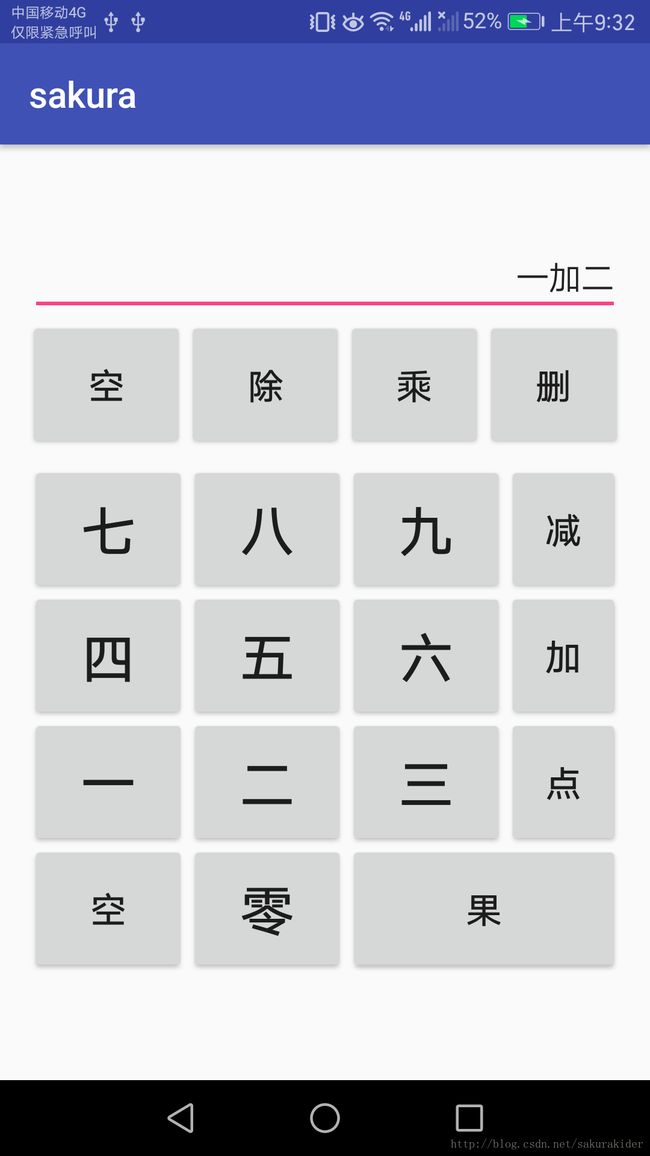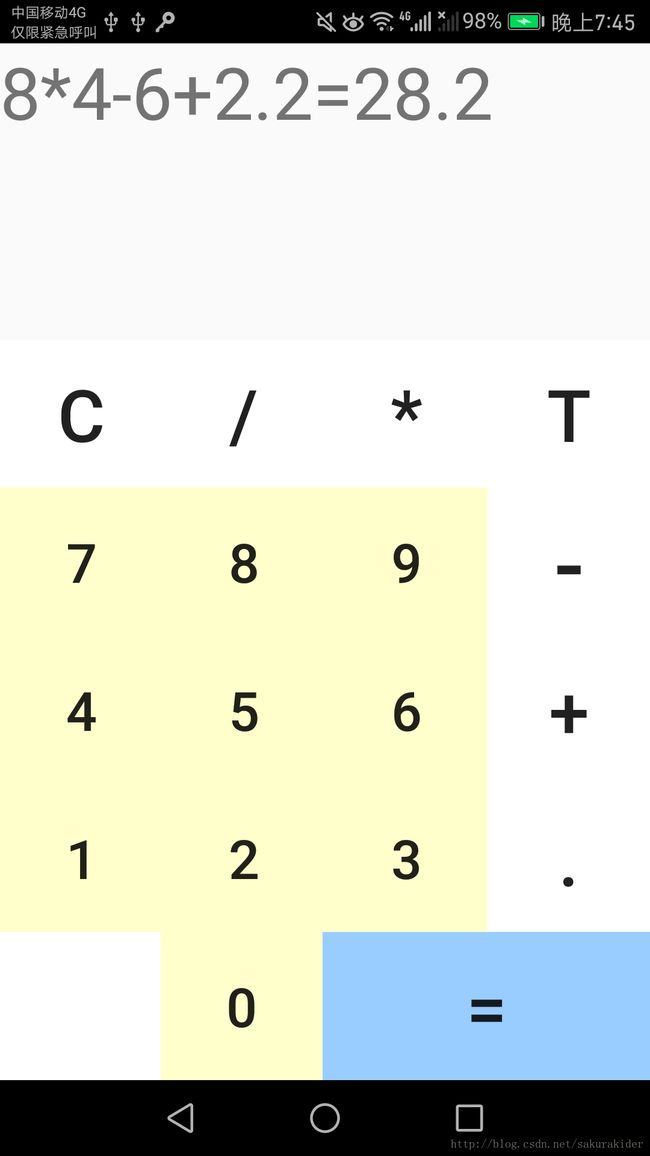Android简单计算器实现
Android简单计算器实现
前言
最近刚开始学习安卓,只是简单的看到布局那块,就开始上手写了,从布局那里就开始各种乱,还到处拖按钮,一开始的第一版只能实现两个数的运算,比较简单,就是简单的上了个手,在第二版里实现了多项式的运算(没加括号的),最难的是里面的逻辑代码算法那块。

这个是我第一版的,,,可能我是有毒吧,,这样的计算器,不被人打死就好

这个是我第二版的,,实现了许多计算优先级的问题,可以记住上次计算的结果,错误输入的时候会提示
在UI那块
我采用的是嵌套的布局结构,在最外层是用的是LinearLayout的线性竖线布局,内层是LinearLayout的线性横向布局,每个内层里横向布局,设置权重,让按钮很整体很好布局。外层的竖线线性布局,可以让按钮紧贴最下面,方便,调整Testview和每个横行的比例关系,下面上代码:
在app/src/main/res/layout/中的activity_main.xml中的代码
<LinearLayout xmlns:android="http://schemas.android.com/apk/res/android"
android:orientation="vertical"
android:layout_width="match_parent"
android:layout_height="match_parent"
>
<LinearLayout
android:layout_width="match_parent"
android:layout_height="0dp"
android:orientation="horizontal"
android:layout_weight="2"
>
<TextView
android:layout_width="match_parent"
android:layout_height="match_parent"
android:id="@+id/et_input"
android:textSize="40sp"
/>
LinearLayout>
<LinearLayout
android:layout_width="match_parent"
android:layout_height="0dp"
android:layout_weight="1"
android:orientation="horizontal"
android:weightSum="4"
>
<Button
android:layout_width="0dp"
android:layout_height="match_parent"
android:text="C"
android:textSize="40sp"
android:id="@+id/btn_clear"
android:layout_weight="1"
android:background="#ffffff"/>
<Button
android:layout_width="0dp"
android:layout_height="match_parent"
android:text="/"
android:textSize="40sp"
android:id="@+id/btn_divide"
android:layout_weight="1"
android:background="#ffffff"/>
<Button
android:layout_width="0dp"
android:layout_height="match_parent"
android:text="X"
android:textSize="40sp"
android:id="@+id/btn_multiply"
android:layout_weight="1"
android:background="#ffffff"/>
<Button
android:layout_width="0dp"
android:layout_height="match_parent"
android:text="T"
android:textSize="40sp"
android:id="@+id/btn_del"
android:layout_weight="1"
android:background="#ffffff"/>
LinearLayout>
<LinearLayout
android:layout_width="fill_parent"
android:layout_height="0dp"
android:layout_weight="1"
android:gravity="center"
android:weightSum="4"
>
<Button
android:layout_width="0dp"
android:layout_height="match_parent"
android:text="7"
android:textSize="30sp"
android:id="@+id/btn_7"
android:layout_weight="1"
android:background="#ffffcc"/>
<Button
android:layout_width="0dp"
android:layout_height="match_parent"
android:text="8"
android:textSize="30sp"
android:id="@+id/btn_8"
android:layout_weight="1"
android:background="#ffffcc"/>
<Button
android:layout_width="0dp"
android:layout_height="match_parent"
android:text="9"
android:textSize="30sp"
android:id="@+id/btn_9"
android:layout_weight="1"
android:background="#ffffcc"/>
<Button
android:layout_width="0dp"
android:layout_height="match_parent"
android:text="-"
android:textSize="50sp"
android:id="@+id/btn_minus"
android:layout_weight="1"
android:background="#ffffff"/>
LinearLayout>
<LinearLayout
android:layout_width="fill_parent"
android:layout_height="0dp"
android:orientation="horizontal"
android:layout_weight="1"
android:weightSum="4"
>
<Button
android:layout_width="0dp"
android:layout_height="match_parent"
android:text="4"
android:textSize="30sp"
android:id="@+id/btn_4"
android:layout_weight="1"
android:background="#ffffcc"/>
<Button
android:layout_width="0dp"
android:layout_height="match_parent"
android:text="5"
android:textSize="30sp"
android:id="@+id/btn_5"
android:layout_weight="1"
android:background="#ffffcc"/>
<Button
android:layout_width="0dp"
android:layout_height="match_parent"
android:text="6"
android:textSize="30sp"
android:id="@+id/btn_6"
android:layout_weight="1"
android:background="#ffffcc"/>
<Button
android:layout_width="0dp"
android:layout_height="match_parent"
android:text="+"
android:textSize="40sp"
android:id="@+id/btn_plus"
android:layout_weight="1"
android:background="#ffffff"/>
LinearLayout>
<LinearLayout
android:layout_width="fill_parent"
android:layout_height="0dp"
android:orientation="horizontal"
android:layout_weight="1"
android:weightSum="4"
>
<Button
android:layout_width="0dp"
android:layout_height="match_parent"
android:text="1"
android:textSize="30sp"
android:id="@+id/btn_1"
android:layout_weight="1"
android:background="#FFFFCC"/>
<Button
android:layout_width="0dp"
android:layout_height="match_parent"
android:text="2"
android:textSize="30sp"
android:id="@+id/btn_2"
android:layout_weight="1"
android:background="#FFFFCC"/>
<Button
android:layout_width="0dp"
android:layout_height="match_parent"
android:text="3"
android:textSize="30sp"
android:id="@+id/btn_3"
android:layout_weight="1"
android:background="#FFFFCC"/>
<Button
android:layout_width="0dp"
android:layout_height="match_parent"
android:text="."
android:textSize="40sp"
android:id="@+id/btn_point"
android:layout_weight="1"
android:background="#FFFFFF"/>
LinearLayout>
<LinearLayout
android:layout_width="fill_parent"
android:layout_height="0dp"
android:orientation="horizontal"
android:layout_weight="1"
android:weightSum="4"
>
<Button
android:layout_width="0dp"
android:layout_height="match_parent"
android:text="("
android:textSize="30sp"
android:id="@+id/btn_left"
android:layout_weight="1"
android:background="#FFFFCC"/>
<Button
android:layout_width="0dp"
android:layout_height="match_parent"
android:text="0"
android:textSize="30sp"
android:id="@+id/btn_0"
android:background="#FFFFCC"
android:layout_weight="1" />
<Button
android:layout_width="0dp"
android:layout_height="match_parent"
android:text=")"
android:textSize="30sp"
android:id="@+id/btn_right"
android:layout_weight="1"
android:background="#FFFFCC"/>
<Button
android:layout_width="0dp"
android:layout_height="match_parent"
android:text="="
android:textSize="30sp"
android:id="@+id/btn_equal"
android:background="#99CCFF"
android:layout_weight="1" />
LinearLayout>
LinearLayout>逻辑代码
1.在主体部分
思路:就是 按照按钮点击事件的套路,每当点击按钮时,就会执行onClick()的方法,我们在这个方法里加入个switch循环,每个case:是按钮的id,我们申请个private StringBuilder的字符串。每按一个按钮,只要满足要求,不是错误的输入,就调用append()方法,将按钮的值当字符存入这个字符串中,当用户按到等号时,调用另一个java文件的自己写的处理的类(想都写在mainActivity也行啊,不过太长了)。
下面是主体代码
在app/src/main/java/com/example/hasee/MainActivity中的
import android.support.v7.app.AppCompatActivity;
import android.os.Bundle;
import android.view.View;
import android.widget.Button;
import android.widget.TextView;
import java.util.Arrays;
public class MainActivity extends AppCompatActivity implements View.OnClickListener {
Button btn_0;
Button btn_1;
Button btn_2;
Button btn_3;
Button btn_4;
Button btn_5;
Button btn_6;
Button btn_7;
Button btn_8;
Button btn_9;
Button btn_point; //小数点
Button btn_clear; //清除
Button btn_del; //删除
Button btn_plus;
Button btn_minus;
Button btn_multiply;
Button btn_divide;
Button btn_equal;
Button btn_left;
Button btn_right;
private TextView et_input;
private StringBuilder pending = new StringBuilder();
private void initView() {
btn_0 = (Button) findViewById(R.id.btn_0);
btn_1 = (Button) findViewById(R.id.btn_1);
btn_2 = (Button) findViewById(R.id.btn_2);
btn_3 = (Button) findViewById(R.id.btn_3);
btn_4 = (Button) findViewById(R.id.btn_4);
btn_5 = (Button) findViewById(R.id.btn_5);
btn_6 = (Button) findViewById(R.id.btn_6);
btn_7 = (Button) findViewById(R.id.btn_7);
btn_8 = (Button) findViewById(R.id.btn_8);
btn_9 = (Button) findViewById(R.id.btn_9);
btn_point = (Button) findViewById(R.id.btn_point);
btn_clear = (Button) findViewById(R.id.btn_clear);
btn_del = (Button) findViewById(R.id.btn_del);
btn_plus = (Button) findViewById(R.id.btn_plus);
btn_minus = (Button) findViewById(R.id.btn_minus);
btn_multiply = (Button) findViewById(R.id.btn_multiply);
btn_divide = (Button) findViewById(R.id.btn_divide);
btn_equal = (Button) findViewById(R.id.btn_equal);
et_input = (TextView) findViewById(R.id.et_input);
btn_left = (Button) findViewById(R.id.btn_left);
btn_right = (Button) findViewById(R.id.btn_right);
btn_0.setOnClickListener(this);
btn_1.setOnClickListener(this);
btn_2.setOnClickListener(this);
btn_3.setOnClickListener(this);
btn_4.setOnClickListener(this);
btn_5.setOnClickListener(this);
btn_6.setOnClickListener(this);
btn_7.setOnClickListener(this);
btn_8.setOnClickListener(this);
btn_9.setOnClickListener(this);
btn_point.setOnClickListener(this);
btn_plus.setOnClickListener(this);
btn_equal.setOnClickListener(this);
btn_minus.setOnClickListener(this);
btn_multiply.setOnClickListener(this);
btn_del.setOnClickListener(this);
btn_divide.setOnClickListener(this);
btn_clear.setOnClickListener(this);
btn_divide.setOnClickListener(this);
btn_left.setOnClickListener(this);
btn_right.setOnClickListener(this);
}
@Override
protected void onCreate(Bundle savedInstanceState) {
super.onCreate(savedInstanceState);
setContentView(R.layout.activity_main);
initView();
}
public void onClick(View v) {
int last = 0;
if(pending.length()!=0)
{
last = pending.codePointAt(pending.length()-1);
}
switch (v.getId()) {
case R.id.btn_0:
pending = pending.append("0");
et_input.setText(pending);
break;
case R.id.btn_1:
pending = pending.append("1");
et_input.setText(pending);
break;
case R.id.btn_2:
pending = pending.append("2");
et_input.setText(pending);
break;
case R.id.btn_3:
pending = pending.append("3");
et_input.setText(pending);
break;
case R.id.btn_4:
pending = pending.append("4");
et_input.setText(pending);
break;
case R.id.btn_5:
pending = pending.append("5");
et_input.setText(pending);
break;
case R.id.btn_6:
pending = pending.append("6");
et_input.setText(pending);
break;
case R.id.btn_7:
pending = pending.append("7");
et_input.setText(pending);
break;
case R.id.btn_8:
pending = pending.append("8");
et_input.setText(pending);
break;
case R.id.btn_9:
pending = pending.append("9");
et_input.setText(pending);
break;
case R.id.btn_plus:
//if (last >= '0' && last <= '9' ) {
pending = pending.append("+");
// }
et_input.setText(pending);
break;
case R.id.btn_minus:
//if (last >= '0' && last <= '9') {
pending = pending.append("-");
// }
et_input.setText(pending);
break;
case R.id.btn_multiply:
// if (last >= '0' && last <= '9' ) {
pending = pending.append("*");
// }
et_input.setText(pending);
break;
case R.id.btn_divide:
// if (last >= '0' && last <= '9' ) {
pending = pending.append("/");
// }
et_input.setText(pending);
break;
case R.id.btn_point:
if (judje1()) {
pending = pending.append(".");
et_input.setText(pending);
}
break;
case R.id.btn_right:// )右括号
if((last>='0' &&last<='9'||last==')')&&judje2()==1) {
pending = pending.append(")");
et_input.setText(pending);
}
break;
case R.id.btn_left:// (左括号
if((last!='(')||(last<='0' &&last>='9')){
pending = pending.append("(");
et_input.setText(pending);
}
break;
case R.id.btn_del: //删除
if (pending.length() != 0) {
pending = pending.delete(pending.length() - 1, pending.length());
et_input.setText(pending);
}
break;
case R.id.btn_clear: //清空
pending = pending.delete(0, pending.length());
et_input.setText(pending);
break;
case R.id.btn_equal: // =等于
if ((pending.length() > 1)) {
InfixInToDuffix inf = new InfixInToDuffix();
String jieguo;
try {
String a = inf.toSuffix(pending);
jieguo = inf.dealEquation(a);
} catch (Exception ex) {
jieguo = "出错";
}
et_input.setText(pending + "=" + jieguo);
pending = pending.delete(0, pending.length());
if (Character.isDigit(jieguo.charAt(0))) {
pending = pending.append(jieguo);
}
}
break;
default:
break;
}
}
private boolean judje1() {
String a = "+-*/.";
int[] b = new int[a.length()];
int max;
for (int i = 0; i < a.length(); i++) {
String c = "" + a.charAt(i);
b[i] = pending.lastIndexOf(c);
}
Arrays.sort(b);
if (b[a.length() - 1] == -1) {
max = 0;
} else {
max = b[a.length() - 1];
}
if (pending.indexOf(".", max) == -1) {
return true;
} else {
return false;
}
}
private int judje2(){
int a=0,b=0;
for(int i = 0 ; i < pending.length() ;i++){
if(pending.charAt(i)=='(' ) {
a++;
}
if(pending.charAt(i)==')' ) {
b++;
}
}
if(a == b)
return 0;
if(a > b)
return 1;
return 2;
}
}
2.在逻辑算法方面
思路:自己把用户输入的数字和运算符全部在peng这个字符串里,不论咋样,都要把这个字符串里面的计算式子从中缀表达式转化为后缀表达式,,,至于为啥要转换再算表达式,是因为中缀表达式是符合人类的计算但不方便计算机的计算,后缀表达式方便计算机的计算,便于它判断优先级,具体的我给两篇其他人写的东西,了解下
中缀表达式转化为后缀表达式的
http://write.blog.csdn.net/mdeditor
后缀表达式的计算过程的
http://www.nowamagic.net/librarys/veda/detail/2307
别人写的,觉得里面讲的简单明了,很好理解
下面写下自己写的类InfixInToDuffix类
在在app/src/main/java/com/example/hasee/中的重新创建一个InfixInToDuffix,在里面写(这个不是我写的,我只是拿来借用一下)
import java.util.HashMap;
import java.util.List;
import java.util.Map;
import java.lang.*;
import java.util.ArrayList;
import java.util.*;
public class InfixInToDuffix {
//使用集合定义好符号的运算优先级别
private static final Mapbasic =new HashMap();
static {
basic.put('-',1);
basic.put('+', 1);
basic.put('*', 2);
basic.put('/', 2);
basic.put('(', 0);//在运算中 ()的优先级最高,但是此处因程序中需要 故设置为0
}
//将中缀表达式转换为后缀表达式
public String toSuffix(StringBuilder infix){
List queue = new ArrayList(); //定义队列 用于存储 数字 以及最后的 后缀表达式
List stack = new ArrayList(); //定义栈 用于存储 运算符 最后stack中会被 弹空
char[] charArr = infix.substring(0,infix.length()).trim().toCharArray(); //字符数组 用于拆分数字或符号
String standard = "*/+-()"; //判定标准 将表达式中会出现的运算符写出来
char ch = '&'; //在循环中用来保存 字符数组的当前循环变量的 这里仅仅是初始化一个值 没有意义
int len = 0; //用于记录字符长度 【例如100*2,则记录的len为3 到时候截取字符串的前三位就是数字】
for (int i = 0; i < charArr.length; i++) { //开始迭代
ch = charArr[i]; //保存当前迭代变量
if(Character.isDigit(ch)) { //如果当前变量为 数字
len++;
}else if(ch == '.'){ //如果当前变量为 . 会出现在小数里面
len++;
}else if(standard.indexOf(ch) != -1) { //如果是上面标准中的 任意一个符号
if(len > 0) { //长度也有
queue.add(String.valueOf(Arrays.copyOfRange(charArr, i - len, i))); //说明符号之前的可以截取下来做数字
len = 0; //长度置空
}
if(ch == '(') { //如果是左括号
stack.add(ch); //将左括号 放入栈中
continue; //跳出本次循环 继续找下一个位置
}
if (!stack.isEmpty()) { //如果栈不为empty
int size = stack.size() - 1; //获取栈的大小-1 即代表栈最后一个元素的下标
boolean flag = false; //设置标志位
while (size >= 0 && ch == ')' && stack.get(size) != '(') { //若当前ch为右括号,则 栈里元素从栈顶一直弹出,直到弹出到 左括号
queue.add(String.valueOf(stack.remove(size))); //注意此处条件:ch并未入栈,所以并未插入队列中;同样直到找到左括号的时候,循环结束了,所以左括号也不会放入队列中【也就是:后缀表达式中不会出现括号】
size--; //size-- 保证下标永远在栈最后一个元素【栈中概念:指针永远指在栈顶元素】
flag = true; //设置标志位为true 表明一直在取()中的元素
}
if(ch==')'&&stack.get(size) == '('){
flag = true;
}
while (size >= 0 && !flag && basic.get(stack.get(size)) >= basic.get(ch)) { //若取得不是()内的元素,并且当前栈顶元素的优先级>=对比元素 那就出栈插入队列
queue.add(String.valueOf(stack.remove(size))); //同样 此处也是remove()方法,既能得到要获取的元素,也能将栈中元素移除掉
size--;
}
}
if(ch != ')') { //若当前元素不是右括号
stack.add(ch); //就要保证这个符号 入栈
} else { //否则就要出栈 栈内符号
stack.remove(stack.size() - 1);
}
}
if(i == charArr.length - 1) { //如果已经走到了 中缀表达式的最后一位
if(len > 0) { //如果len>0 就截取数字
queue.add(String.valueOf(Arrays.copyOfRange(charArr, i - len+1, i+1)));
}
int size = stack.size() - 1; //size表示栈内最后一个元素下标
while (size >= 0) { //一直将栈内 符号全部出栈 并且加入队列中 【最终的后缀表达式是存放在队列中的,而栈内最后会被弹空】
queue.add(String.valueOf(stack.remove(size)));
size--;
}
}
}
String a = queue.toString();
return a.substring(1,a.length()-1);
}
public String dealEquation(String equation){
String [] arr = equation.split(", "); //根据, 拆分字符串
List list = new ArrayList(); //用于计算时 存储运算过程的集合【例如list中当前放置 100 20 5 / 则取出20/5 最终将结果4存入list 此时list中结果为 100 4 】
for (int i = 0; i < arr.length; i++) { //此处就是上面说的运算过程, 因为list.remove的缘故,所以取出最后一个数个最后两个数 都是size-2
int size = list.size();
switch (arr[i]) {
case "+": double a = Double.parseDouble(list.remove(size-2))+ Double.parseDouble(list.remove(size-2)); list.add(String.valueOf(a)); break;
case "-": double b = Double.parseDouble(list.remove(size-2))- Double.parseDouble(list.remove(size-2)); list.add(String.valueOf(b)); break;
case "*": double c = Double.parseDouble(list.remove(size-2))* Double.parseDouble(list.remove(size-2)); list.add(String.valueOf(c)); break;
case "/": double d = Double.parseDouble(list.remove(size-2))/ Double.parseDouble(list.remove(size-2)); list.add(String.valueOf(d)); break;
default: list.add(arr[i]); break; //如果是数字 直接放进list中
}
}
return list.size()
== 1 ? list.get(0) : "运算失败" ; //最终list中仅有一个结果,否则就是算错了
}
} 改APP图标方面
首先:准备一张你想要的图标图片,把格式改成png(必须这样做,切记切记)
其次:把这张图片放到app/src/main/res/drawable中
最后:在app/src/main/AndroidManifest.xml里
<application
android:allowBackup="true"
android:icon="@drawable/img_5"
//这个是用来改APP的图标的,把里面的一换就行了
android:label="sakura的计算器"
//这个是用来改APP的名字的
android:supportsRtl="true"
android:theme="@style/AppTheme">
<activity android:name=".MainActivity">
<intent-filter>
<action android:name="android.intent.action.MAIN" />
<category android:name="android.intent.category.LAUNCHER" />
intent-filter>
activity>
applicati结
n>总结
写一个计算器其实布局什么的都不难,主体用switch这些也都没撒,就是如何将中缀表达式转换为后缀表达式,然后根据优先级的问题,来计算表达式,自己做的第一个APP,希望对大家有帮助。